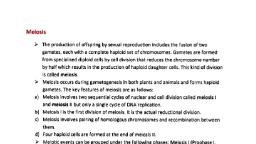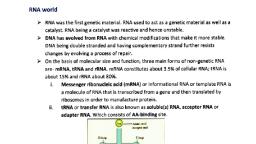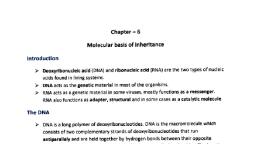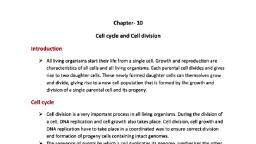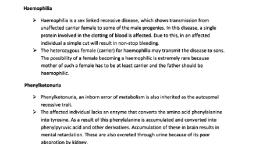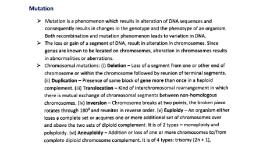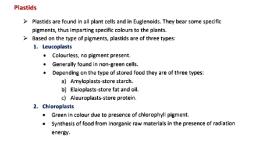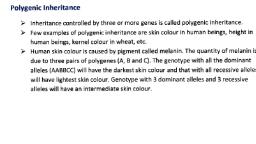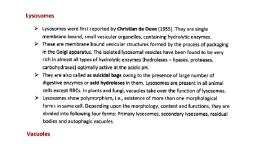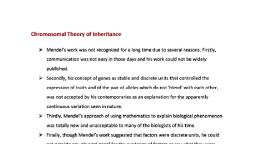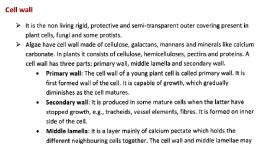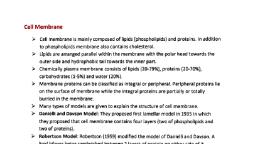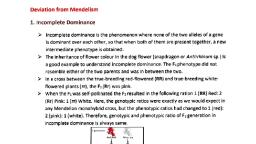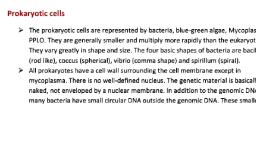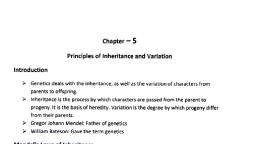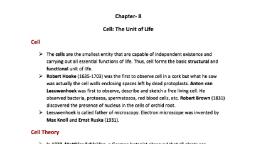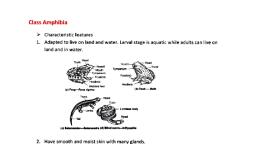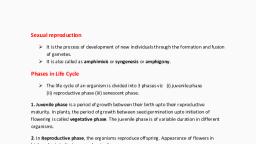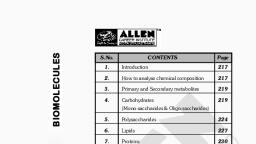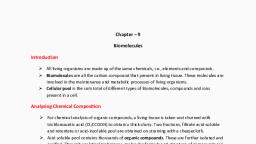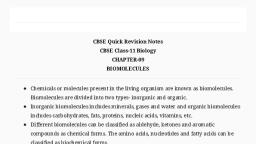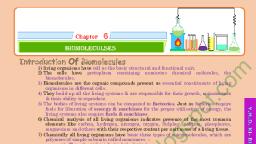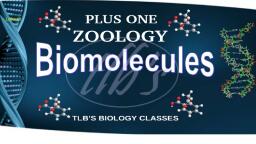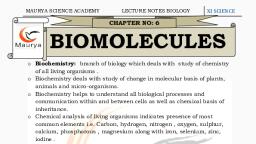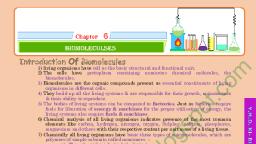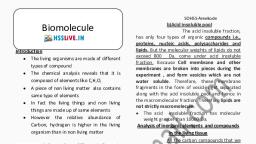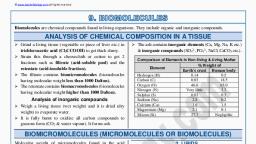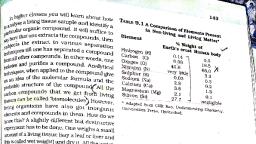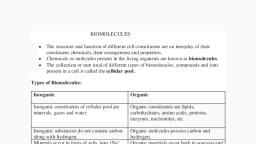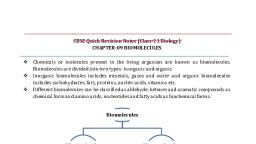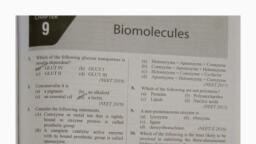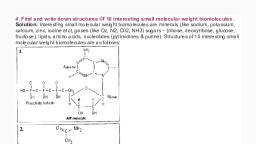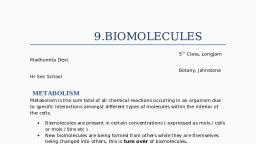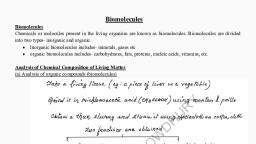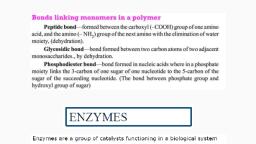Page 1 :
Chapter – 9, Biomolecules, Introduction, ➢ All living organisms are made up of the same chemicals, i.e., elements and compounds., ➢ Biomolecules are all the carbon compound that present in living tissue. These molecules are, involved in the maintenance and metabolic processes of living organisms., ➢ Cellular pool is the sum total of different types of Biomolecules, compounds and ions, present in a cell., , Analysing Chemical Composition, ➢ For chemical analysis of organic compounds, a living tissue is taken and churned with, trichloroacetic acid (Cl3CCOOH) to obtain a thick slurry. Two fractions, filtrate acid-soluble, and retentate or acid-insoluble pool are obtained on straining with a cheesecloth., ➢ Acid soluble pool contains thousands of organic compounds. These are further isolated and, purified. Through analytical techniques, molecular formula and structure of compounds can, be detected., ➢ Inorganic compounds can be analysed by burning a living tissue after it is dried out. After, organic compounds are burnt and released, the ash that remains consists of the inorganic, elements like calcium, magnesium, etc., ➢ Therefore elemental analysis gives elemental composition of living tissues in the form of, hydrogen, oxygen, chlorine, carbon, etc., while analysis for compounds gives an idea of the, kind of organic and inorganic constituents present in living tissues., ➢ Inorganic constituents of living tissues are: Sodium (Na+), Potassium (K+), Calcium (Ca++),, Magnesium (Mg++), Water (H2O) and Compounds (NaCl, CaCO3, PO3-4, SO2-4)., , Amino acids, ➢ Amino acids are organic compounds that contains an amino group and an acidic group as, substituents on the same carbon, i.e., the α-carbon. Therefore, they are called α-amino, acids. They are substituted methanes. There are four substituent groups occupying the four, valency positions. These are hydrogen, carboxyl group, amino group and a variable group, designated as R group. The R group in amino acids could be a hydrogen such as glycine, a, methyl group such as alanine, hydroxyl methyl such as serine, etc., ➢ As particular property of amino acids is the ionizable nature of –NH2 and –COOH groups., Hence in solutions of different pH, the structure of amino acids changes., , Cation, , Zwitter ion, , Anion
Page 2 :
Lipids, ➢ Lipids are fatty acid esters of alcohols and related substances which are insoluble in water, but get dissolved in a number of nonpolar organic solvents like ether, benzene, chloroform,, acetone, etc. However, they can form colloidal complex and get dispersed uniformly in, water in the form of minute droplets. The complex is called emulsion., ➢ Lipids are basically made of carbon, hydrogen and sometimes oxygen. Many lipids contain, small amounts of additional elements like phosphorus, nitrogen and sulphur., ➢ They could be simple fatty acids. A fatty acid has a carboxyl group attached to an R group., The R group could be a methyl (-CH3), or ethyl (-C2H5) or higher number of –CH2 groups. For, example, palmitic acid has 16 carbons including carboxyl carbon. Arachidonic acid has 20, carbon atoms including the carboxyl carbon., ➢ Fatty acids could be saturated or unsaturated. Many lipids have both glycerol and fatty, acids., ➢ Fatty acids are found esterified with glycerol. They can be monoglycerides, diglycerides and, triglycerides. These are also called fats and oils based on melting point. Oils have lower, melting point and hence remain as oil in winters., ➢ Some lipids have phosphorous and a phosphorylated organic compound in them. These are, phospholipids. They are found in cell membrane. Lecithin is one example., , Nucleotides, ➢ Nucleotides are compounds of carbon, hydrogen, oxygen, nitrogen and phosphorus. They, are the units of nucleic acids (DNA and RNA)., ➢ Nucleotides are composed of a nitrogenous base, a pentose sugar and a phosphate. The, molecule consisting of nitrogenous base and sugar is termed nucleoside. Thus, nucleotides, are nucleosides + phosphate., , Fig: Nitrogen bases, Nucleosides and Nucleotide, , Carbohydrates, ➢ Carbohydrates are the most abundant organic molecules present in nature. They represent, combinations of carbon, hydrogen and oxygen., ➢ Carbohydrates can be generally represented by the empirical formula Cn (H2O)n where ‘n’ is, an integer., ➢ Carbohydrates can be aldoses or ketoses, depending upon whether they have an aldehyde, or ketone group. In addition to aldehydes and ketones, the polyhydric alcohols, in which
Page 3 :
the aldehyde or ketone group has been reduced to an alcohol group, also occur naturally in, foods., ➢ Based on the number of sugar units and the complexity, carbohydrates can be classified into, monosaccharides, oligosaccharides and polysaccharides., ➢ Hexoses are mainly white crystalline and sweet in nature e.g., fructose is the sweetest of all, naturally occurring sugars. It is also called “fruit sugar”. Glucose is the most important, monosaccharide in living system and is also called “grape sugar”. The monosaccharide have, an amino group (-NH2). Glucosamine forms chitin, hyaluronic acid and chondroitin sulphate., Galactosamine is similarly a component of chondroitin sulphate., ➢ Oligosaccharides are important for cell recognition, cell attachment and act as receptor, molecules., , Primary and Secondary Metabolites, ➢ Metabolites are the intermediate products of metabolic reactions catalysed by various, enzymes that naturally occur within cells. These are grouped into primary and secondary, metabolites., Types of Metabolites, 1. Primary metabolites, • Some of the organic compounds like carbohydrates, fats, proteins, nucleic acids,, etc., are required for basic metabolic processes and are directly involved in normal, growth, development and reproduction. These organic compounds are called, primary metabolites., 2. Secondary metabolites, • Many plants, fungi and microbes of certain genera synthesise a number of organic, compounds which are not involved in primary metabolism and seem to have no, direct function in growth and development of organism. These compounds are, called secondary metabolites, e.g., gum, resin, rubber, etc., • Types of secondary metabolites, a. Isoprenoids or terpenoides- e.g., rubber, steroids, carotenoids., b. Nitrogen containing compounds- e.g., alkaloids, glycosides, glucosinolates., c. Phenolic compounds- e.g., tannins, flavonoids, lignin, etc., , Biomacromolecules, ➢ They have molecular weights ranging from 18 to around 800 daltons (Da) approximately., ➢ The acid insoluble fraction, has only four types of organic compounds, i.e., proteins,, nucleic acids, polysaccharides and lipids. These classes of compounds with the exception, of lipids, have molecular weights in the range of ten thousand daltons and above. Those, which have molecular weights less than one thousand dalton and are usually referred to as, micromolecules while those which are found in the acid insoluble fraction are called, macromolecules., ➢ Average composition of living cell is : Water – 70-90%, Proteins – 10-15%, Carbohydrates –, 3%, Lipids – 2%, Nucleic acids – 5-7% and Ions – 1%.
Page 4 :
Proteins, ➢ Proteins are polypeptides. They are linear chains of amino acids linked by peptide bonds., ➢ Each protein is a polymer of amino acids. As there are 20 types of amino acids., ➢ Amino acids can be essential or non-essential. Certain amino acids are essential for our, health and they have to be supplied through our diet. Hence, dietary proteins are the source, of essential amino acids. The latter are those which our body can make, while we get, essential amino acids through our diet/food., ➢ Proteins carry out many functions in living organisms, some transport nutrients across cell, membrane, some fight infectious organisms, some are hormones, some are enzymes., ➢ Collagen is the most abundant protein in animal world and Ribulose bisphosphate, Carboxylase-Oxygenase (RuBisCO) is the most abundant protein in the whole of the, biosphere., , Polysaccharides, ➢ Polysaccharides are condensation products of more than ten monosaccharide units; such as, starch and dextrin, which may be linear or branched polymers., ➢ Polysaccharides are also called glycans. They are long chained which may be branched or, unbranched., ➢ Depending upon the composition, polysaccharides are of two types, homopolysaccharides, and heteropolysaccharides., ➢ Homopolysaccharides or homoglycans are those complex carbohydrates which are formed, by polymerisation of only one type of monosaccharide monomers, e.g., Cellulose, starch,, glycogen, chitin., ➢ Heteropolysaccharides or heteroglycans are those complex carbohydrates which are, produced by condensation of two or more types of monosaccharide or their derivations,, e.g., Hyaluronic acid, keratin sulphate, heparin, etc., , Types of Polysaccharides, Storage polysaccharides, ➢ Some homopolysaccharides are stored form of energy. They are those polysaccharides, which serve as reserve food., ➢ The two main storage polysaccharides are starch and glycogen., - Starch: It is the storage polysaccharide of most plants. It is polyglucan, homosaccharide and is formed as an end product of photosynthesis. Starch consists, of two components, amylose and amylopectin. Both of these are formed by, condensation of α-D-glucose. In amylose, the successive glucose units (200-1000), are linked by 1-4 α-linkages that is in the form of continuous straight chain but, arranged helically. Amylopectin contains larger number of glucose units in a straight, chain which bears several side chains. Starch forms helical secondary structures., Starch can hold I2 molecules in the helical portion. The starch-I2 is blue in colour., - Glycogen: It is the polysaccharide food reserve of animals, bacteria and fungi. It is, popularly called animal starch. It has about 30,000 glucose residues joined together, by α (1, 4) glycosidic bonds and α (1, 6) glycosidic bonds at branching points.
Page 5 :
➢ Inulin is a fructan storage polysaccharide of roots and tubers of Dahlia are related plants., Inulin is not metabolized in human body and is readily filtered through the kidney., , Structural polysaccharides, ➢ These polysaccharides make the structural framework of the cell wall in plants and skeleton, of some animals., - Chitin: It is the second most abundant organic substance. Chitin is found as the, structural component of fungal cell walls and exoskeleton of anthropods. It provides, both strength and elasticity to the structure it forms. In chitin, monomer unit is a, nitrogen containing glucose derivative known as N-acetyl glucosamine. It has an, unbranched configuration and monomers are joined together by 1-4 β-linkages., - Cellulose: It is a fibrous, tough, water insoluble substance found in the cell wall of, plants, some protists. Paper made from plant pulp and cotton fibre is cellulosic., Cellulose is a homopolysaccharides composed of β-D glucose units linked by β (1 4), glycosidic bonds. Cellulose molecules have unbranched and linear chains., , Mucosubstances, ➢ Some heteropolysaccharides serve as Mucosubstances. These are mucus or slime forming, substances., - Mucopolysaccharides: They are slimy substances which posses acidic or aminated, polysaccharides formed from galactose, mannose, sugar derivatives and uronic, acids. Mucopolysaccharides are found in both plants and animals. They may be, attached to a protein molecule to form a proteoglycan. Proteoglycans provide the, ground or packing substance of connective tissue. E.g., hyaluronic acid, chondroitin, sulphate and heparin., - Mucoproteins (glycoproteins): The protein with conjugated mucosaccharides form, mucus. These are found in stomach, nasal secretion, intestine, vagina and are, antibacterial and protective in function., , Nucleic acids, ➢ These are polynucleotides. For nucleic acids, the building block is a nucleotide. A nucleotide, has three chemically distinct components. One is a heterocyclic compound, the second is a, monosaccharide and the third is a phosphoric acid or phosphate., ➢ The heterocyclic compounds in nucleic acids are the nitrogenous bases named adenine,, guanine, uracil, cytosine and thymine. Adenine and guanine are substituted purines while, the rest are substituted pyrimidines. The skeletal heterocyclic ring is called as purine and, pyrimidine respectively. The sugar found in polynucleotides is either ribose or 2’, deoxyribose. A nucleic acid containing deoxyribose is called deoxyribonucleic acid (DNA), while that which contains ribose is called ribonucleic acid (RNA)., , Structure of Proteins, ➢ Every protein has a three-dimensional structure that corresponds to its functions. The four, level structural organisation in proteins are primary, secondary, tertiary and quaternary.
Page 6 :
1. Primary structure, • It is the linear sequence of amino acids in a polypeptide chain. Primary structure, describes the basic structure of a protein i.e., number and sequence of amino acids, in each polypeptide constituting the protein. This structure of proteins is most, unstable., 2. Secondary structure, • It is the development of new stearic relationships of amino acids present in the, linear sequence inside the polypeptides. There are insoluble in water and fibrous in, appearance. There are 2 types of secondary structures., • α helix – Right handed rotation of spirally coiled chain with approximately 31/2, amino acids in each turn. This structure has intramolecular hydrogen bonding i.e.,, between two amino acids of same chain e.g., Keratin, Myosin, Tropomyosin., • β helix – Protein molecule has zig-zag structure. Two or more protein are held, together by intermolecular hydrogen bond, e.g., Fibroin (silk)., 3. Tertiary structure, • It is formed by the further complex bending and folding of secondary structure to, form various types like sphere, rod or fibre. Tertiary structure is stabilized by several, types of bonds – peptide bonds, hydrogen bonds, ionic bonds, disulphide bonds,, hydrophobic bonds, van der Waals interactions, etc., 4. Quaternary structure, • It is found only in multimeric proteins and consist of two or more polypeptide, chains. Each polypeptide develops its own tertiary structure and functions as subunit, of protein. E.g., insulin, collagen, haemoglobin, etc., , Enzymes, ➢ Enzymes are organic catalysts which catalyse biochemical reactions without being utilizing, themselves., ➢ Enzymes occur in colloidal state and are often produced in inactive form called proenzymes, or zymogens. These are converted to active enzymes in the presence of specific factor like, pH, substrate, etc. All known enzymes are proteins but all proteins are not enzymes., Ribozyme, ribonuclease-P and peptidyl transferase are three non-protein enzymes., , Classification and Nomenclature of Enzymes, According to modern system of enzyme classification, introduced by International Union of, Biochemistry and Molecular Biology (IUBMB) in 1961, enzymes are classified into six classes, based, on the type of reaction catalysed., ➢ Oxidoreductases/dehydrogenases: These enzymes catalyse the oxidation-reduction, reactions by transfer of electrons. These enzymes are of three types – (a) Oxidases, e.g.,, cytochrome oxidase, (b) dehydrogenases, e.g., succinate dehydrogenase (c) reductases, e.g.,, nitrate reductases., S reduced + S’oxidised, S oxidized + S’reduced, ➢ Transferases: These enzymes catalyse the transfer of specific group (G) other than hydrogen, from one substrate (S) to another (S’). The group transfer does not occur in free state.
Page 7 :
S – G + S’, S + S’ - G, ➢ Hydrolases: These enzymes catalyse splitting of larger molecules into smaller ones by, addition of water, i.e., with the help of hydrogen and hydroxyl groups. E.g., amylase,, sucrose, lactase., X, Y, C, , C, , X–Y+C, , ➢ Lyases: These enzymes catalyse the breakdown of specific covalent bonds and removal of, groups without hydrolysis producing double bonds or removal of double bonds by adding, groups., ➢ Isomerases: These enzymes catalyse the change of a substrate into a related isomeric form, by rearrangement of molecules. These enzymes too are of three types: (i) Isomerases, (ii), Epimerases (iii) Mutases, ➢ Ligases: These enzymes catalyse the joining of two substrate molecules by utilising the, energy from hydrolysis of ATP. E.g., enzymes which catalyse joining of C – O, C – S, C – N,, P – O, etc. bonds., , Characteristics of Enzymes, ➢ Proteinaceous nature: Enzymes are usually globular proteins except two RNA enzymes., ➢ Efficiency: The efficiency of enzyme depends upon the number of active sites present over, an enzyme. The number of substrate molecules changed per minute by an enzyme is called, turn over number., ➢ Enzyme specificity: Enzymes are highly specific in their action. Different enzymes act on, same substrate but give rise to different products., ➢ Chain of reactions: Enzymatic reactions are not isolated, they occur in quick succession or a, team of enzymes work together to perform multistep reactions., ➢ Colloidal nature: Enzymes are hydrophilic and form hydrosol in free state., ➢ Reversibility: Almost all enzymatic reactions are reversible., ➢ Enzyme-substrate complex: The active sites of enzymes have crevices or conformations that, fit in the substrates in a complementary fashion forming a complex known as enzyme, substrate complex. The latter are changed into products. As soon as the products are, released, the active sites become free to perform another catalytic act., , Enzymes bring about High Rates of Chemical Conversions, ➢ The chemical which is converted into a product is called a ‘substrate’. Hence, enzymes, i.e.,, proteins with three dimensional structures including an ‘active site’, convert a substrate (S), into a product (P)., ➢ All enzymes have a specific three-dimensional structure, a part of it is known as active site, into which substrate fits. The point where substrate is bound on the active site is known as, the substrate binding site. There is an obligatory formation of an ‘ES’ complex., ➢ During the state where substrate is bound to the enzyme active site, a new structure of the, substrate called transition state structure is formed. Very soon, the product is released from, the active site. If ‘P’ is at a lower level than ‘S’, the reaction is an exothermic reaction and is
Page 8 :
not supplied energy in order to form the product. However, whether it is an exothermic or, spontaneous reaction or an endothermic or energy requiring reaction, the ‘S’ has to go, through a much higher energy state or transition state. The difference in average energy, content of ‘S’ from that of this transition state is called ‘activation energy’., , Fig.: Concept of activation energy, , Nature of enzyme action, ➢ Each enzyme (E) has a substrate (S) binding site in its molecule to produce highly reactive, enzyme-substrate complex (ES). This complex is short-lived and dissociates into its, product(s) P and the unchanged enzyme with an intermediate formation of the enzymeproduct complex (EP). The formation of the ES complex is essential for catalysis., E+S, ES, EP, E+P, ➢ The catalytic cycle of an enzyme action can be described as follows:, i., The substrate binds to the active site of the enzyme, fitting into the active site., ii., The binding of the substrate induces the enzyme to alter its shape, fitting more tightly, around the substrate., iii., The active site of the enzyme, now is close proximity of the substrate breaks the, chemical bonds of the substrate and the new enzyme-product complex is formed., iv., The enzyme releases the products of the reaction and the free enzyme is ready to bind, to another molecule of the substrate and run through the catalytic cycle once again., , Factors affecting enzyme activity, ➢ The activity of an enzyme can be affected by a change in the conditions which can alter the, tertiary structure of the protein. Optimum temperature for enzyme activity is 300C – 400C in, animals and 200C – 300C in plants. High temperature denatures enzymes due to degradation, of linkages in its polypeptide chain whereas low temperature inactivates them due to, reduction in speed of molecular movement. Most intracellular enzymes function near, neutral pH with the exception of several digestive enzymes which work either in acidic range, of pH or alkaline., ➢ Low temperature preserves the enzyme in a temporarily inactive state whereas high, temperature destroys enzymatic activity because proteins are denatured by heat.
Page 9 :
Fig.: Effect of change in concentration of substrate on enzyme activity, , ➢ With the increase in substrate concentration, the velocity of the enzymatic reaction rises at, first. The reaction ultimately reaches a maximum velocity (Vmax) which is not exceeded by, any further rise in concentration of the substrate., ➢ Michaelis-Menten equation: To determine the effect of substrate concentration in, enzymatic reaction Leonor Michaelis and Maud Menten (1913) proposed a mathematical, model and derived a relationship which is mathematically expressed as, 𝑉=, , 𝑉𝑚𝑎𝑥 [𝑆], 𝐾𝑚+[𝑆], , Km = Michaelis – Menten constant i.e., the substrate concentration to produce half maximum, velocity. V = Velocity of reaction, Vmax = Maximum velocity, [S] = Substrate concentration., , Inhibition of enzyme action, ➢ The activity of an enzyme is also sensitive to the presence of specific chemicals that bind to, the enzyme. When the binding of the chemical shuts off enzyme activity, the process is, called inhibition and the chemical is called inhibitor., ➢ Reversible inhibition is temporary and is overcome by increased concentration of substrate,, dilution and dialysis. Irreversible inhibition is of permanent nature, in which the inhibitor, combines with a specific functional group of enzyme through covalent bond. On the basis of, competitiveness enzyme inhibition can be divided into – competitive inhibition, noncompetitive inhibition and allosteric inhibition., ➢ Inhibition of enzyme action, 1. Competitive inhibition, • Reversible. Occurs due to substrate or increase enzyme analogue., 2. Non-competitive inhibition, • Inhibitor forms a complex with enzyme at a site other than the active site., 3. Allosteric inhibition, • Inhibitor binds to enzyme at a specific site other than active site and change the, structure of active site to affect substrate binding.
Page 10 :
➢ Allosteric modulation or feedback inhibition is an enzyme regulatory mechanism where a, product or intermediates of a reaction functions as a temporary allosteric inhibitor, if its, concentration crosses the threshold value. The end product inhibitor functions as negative, modulator and the enzyme inactivated is called allosteric enzyme. Michaelis-Menten or Km, constant is not applicable in allosteric enzymes., , Co-factors, ➢ Co-factors called non-protein constituents bound to the enzyme to make the enzyme, catalytically active. In these instances, the protein portion of the enzymes is called the, apoenzyme. Three kinds of co-factors may be identified: prosthetic groups, co-enzymes and, metal ions., ➢ Prosthetic groups: These are organic compounds and are distinguished from other cofactors in that they are tightly bound to the apoenzyme. For example, in peroxidase and, catalase, which catalyze the breakdown of hydrogen peroxide to water and oxygen, haem is, the prosthetic group and it is a part of the active site of the enzyme., ➢ Co-enzyme: These are also organic compounds but their association with the apoenzyme is, only transient, usually occurring during the course of catalysis. Furthermore, co-enzymes, serve as co-factors in a number of different enzyme catalyzed reactions. The essential, chemical components of many coenzymes are vitamins, e.g., co-enzyme nicotinamide, adenine dinucleotide (NAD) and NADP contain the vitamin niacin., ➢ Metal ions: A number of enzymes require metal ions for their activity which form, coordination bonds with side chains at the active site and at the same time form one or, more coordination bonds with the substrate, e.g., zinc is a co-factor for the proteolytic, enzyme carboxypeptidase.

